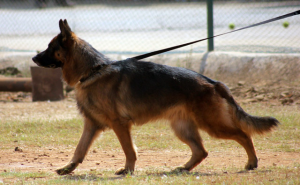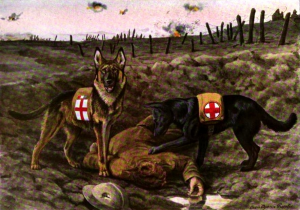If a Doberman Were Human How Would It Look Art
Afola, one of the German Shepherd Dogs with the U.S. Air Force, awaits commands from her handler. (U.S. Air National Guard photo by Staff Sgt. Patrick Evenson) To learn how you tin support military working dogs deployed in combat zones overseas, visit MWDTSA's home page.
By Brad Cohick, MWDTSA
Development of German Shepherd Dogs every bit a Breed and Early Trials
Between 1899 and 1914, the German Shepherd Canis familiaris (GSD) was adult by Helm Max von Stephanitz of the High german Army to be a working canis familiaris. Many years of selective convenance by Stephanitz honed the traits of intelligence, loyalty, dedication, and tenacity needed for war machine and police applications. Eager to show the prowess of the new breed, Stephanitz loaned these new dogs to German police departments–the start K9 Corps.
During this trial period with German constabulary, these new dogs showed great promise in areas such equally obedience, tracking, and protection. Stephanitz believed these dogs could also be useful to the German military. After these early trials with High german Police units, Stephanitz sought to have GSDs added to German Military units. The timing could non have been amend for Stephanitz and his new German Shepherd Dogs.

German language Shepherd Dog (GSD) Photo: PDPics.com
Earth War I
In 1914, at the beginning of World State of war I, German Shepherd Dogs began serving with the German Military. They performed a number of tasks on the battlefield and within the ranks of the German Regular army. These new dogs served as sentries, messengers, and ammunition carriers. They proved themselves specially capable in aiding wounded soldiers on the battleground. They even led injured and blinded soldiers off the battlefield to safety and medical attention. This latter act past the new breed somewhen led to the development of the outset seeing heart dog, an important function the GSD still serves today.
While at beginning tickled by the apply of dogs on the battleground, the soldiers on both sides of the disharmonize were chop-chop impressed. They saw these new dogs performing numerous heroic acts under stressful and dangerous weather. In fact, soldiers were then impressed past the dogs' capabilities that after the conflict, the Germans, likewise as the Americans and the English, began to develop their own cadre of German language Shepherd Dogs for employ in the military. GSDs would prove themselves once again in conflict when World War Ii broke out in 1939.

Photo: publicdomainclip-art.blogspot.com
World War Ii
During WWII, the Germans again utilized GSDs, and the U.Southward. began deploying them, as well. U.South. GSDs served mainly every bit messengers, helping soldiers to communicate on the battleground. GSDs besides acted every bit guards and search and rescue dogs during the war. In all of these roles, the GSDs performed well. This led to the establishment of many K-9 training camps, where GSDs began preparation regularly for service in the U.S. Military.
Beginning in August 1942, the U.S. Army Quartermaster Corps established dog preparation centers at Forepart Royal, VA; Fort Robinson, NE; Cat Island (Gulfport), MS; Camp Rimini (Helena), MT; and San Carlos CA. The Grand-9 Corps initially accepted thirty-ii breeds of dogs for training.
By 1944, however, the military reduced that list to vii: German Shepherds, Doberman Pinschers, Belgian Sheep Dogs, Siberian huskies, subcontract collies, Eskimo dogs, and Malamutes. Today, GSDs are the only breed still trained past the U.S. Armed forces from that original list. Mod additions include the Belgian Malinois and Labrador Retrievers now being trained and mobilized as War machine Working Dogs (MWDs).
Formal training
Training for dogs at these K-9 Camps lasted between 8 and 12 weeks and consisted of "basic training" to get the dogs accustomed to military life. After this initial twelve-week training menstruation, the dogs would go on to a specialized training course in one of four areas: Lookout Canis familiaris preparation; Watch or Patrol Domestic dog grooming; Messenger Dog training; or Mine Detection Dog training.
Later successful completion of the specialized training, the dogs and their handlers would be organized into State of war Dog Platoons. During the course of Globe War II, the military deployed xv War Dog Platoons to the European and Pacific Theaters of War. Seven served in the European Theater and eight in the Pacific Theater. It has been said that while on patrol in the Pacific Theater with a War Domestic dog Platoon, no units were ever ambushed thanks to the One thousand-9s assigned to those units. Many of the dogs trained and deployed during WWII were German language Shepherd Dogs.
The Korean War
Subsequently World War Ii, due to lack of interest and budget issues, the military cancelled and closed well-nigh of the War Domestic dog Programs. The 26th Picket Dog Platoon, nonetheless, stayed intact to some degree and moved from Front Royal, Virginia to Fort Riley, Kansas in 1948. On Dec 7th, 1951, the responsibility for dog training was transferred to the Military Police Corps. The 26th Lookout man Domestic dog Platoon moved once more to Fort Carson, Colorado.
The 26th Scout Dog Platoon was the only active War Dog Platoon to serve in the Korean State of war. It served with honor and stardom in Korea from June 12th, 1951 to June 26th, 1953. Platoon members were awarded a total of 3 Silver Stars, six Bronze Stars for Valor, and thirty-five Bronze Stars for meritorious service. On Feb 27th, 1953, the Department of the Army recognized the accomplishments of the platoon in Full general Society No. 21.
Ane Canis familiaris who proved an outstanding success with the 26th Infantry Sentinel Dog Platoon in Korea was Scout Canis familiaris York (011X). York completed 148 combat patrols, the terminal one coming the day before the Armistice was signed officially ending the war. On July 1, 1957, the War Dog Training Center was moved from Fort Carson, Colorado to Fort Benning, Georgia¹.
______________
¹Webpage, 47th Scout Dog Platoon, http://www.47ipsd.us/47k9hist.htm
Vietnam
During the initial phases of the Vietnam War, German Shepherds were used mainly on Air Strength installations as sentinel dogs. However, equally the war escalated, The United States Marine Corps entered into a service agreement with the US Army to accept them train German language Shepherds as scout dogs. This would be the outset fourth dimension since Globe War II that the Marines had used scout dogs. Two Marine watch canis familiaris platoons were deployed to Vietnam in February 1966.
The Marines kenneled their dogs most Da Nang at Army camp Kaiser, named subsequently the first Marine scout dog to be killed in activity in Vietnam. The first Army scout canis familiaris platoon was deployed to Vietnam when the 25th IPSD arrived at Tan Son Nhut Air Base of operations in June 1966. Betwixt late 1965 and Jan 1969, twenty-two Army Scout Dog Platoons (including the 47th IPSD) and Four Marine Scout Canis familiaris Platoons were deployed to Vietnam².
______________
²Ibid
Dogs are comrades, non equipment
Over nine,000 handlers and 4,000 dogs served in the Vietnam War. The final disposition of the dogs after the war is a pitiful and disgraceful episode in our military'south history, however. At the time, the dogs were viewed as equipment by the military, and disposition of the dogs after the war was done in the most economical manner. The dogs were given to the reluctant Due south Vietnamese military if possible for an unknown disposition, and at worst, were euthanized or simply left to fend for themselves. A nearly despicable and shameful ending for the beautiful and heroic dogs who had served our military personnel so gallantly on the battlefield.
This pitiful episode led to a large public outcry. In response, the military pledged not to dispose of armed services working dogs in the same manner. Congress somewhen passed a law that allows armed services dogs to have an honorable retirement. President Clinton signed a bill in Nov 2000 (H.R. 5314), which amended title 10 of the United states of america Code. This allowed for the adoption of retired armed forces working dogs to former handlers and other qualified civilians.
Now, these life-saving dogs in the armed services can finally wait forward to a comfortable and dignified retirement.
Author's Note:
According to a quondam Vietnam MWD Handler here at MWDTSA, GSDs served in Vietnam not just as Picket Dogs but also equally Mine & Tunnel dogs. The advent of IHS fever helped the Us military decide not to bring dwelling house GSDs, since they and near US bred dogs were subject field to it. Later on Vietnam, all canis familiaris units except AF were disbanded. Due to the "overbreeding" of American GSDs, the AF began its favoritism toward the Malinois, including a breeding plan.
German Shepherd Dogs: 9/11 and Beyond
German Shepherd Dogs take been part of the US Military's War machine Working Domestic dog program since the stop of the Vietnam war, through the Cold State of war years and upward to today's climate of global terrorism and asymmetric threats. Co-ordinate to a recent commodity in the New York Times, "German Shepherds and Belgian Malinois are the most common breeds of dogs used by military operators, considering they take the best overall combination of slap-up sense of odor, endurance, speed, force, courage, intelligence, and adaptability to almost any climatic condition."
Currently, the Regular army has approximately 600 dog teams, which have seen service in Iraq and Afghanistan³. The backbone and loyalty of these dogs have continued to salvage lives and prevent injuries since creation of the K-nine Corps.
Many of the dogs on these current teams are High german Shepherds, and they serve in many roles and perform many duties. Today, we can run across German Shepherds performing HALO jumps with Special Operators and inserting from boats with Navy SEAL Teams. These dogs continue to be valued members of our Military machine and patriotic guardians of our freedom.
German Shepherd Dogs likely will have a identify in our military for years to come. They have served with distinction in many theaters and in many conflicts effectually the world. Should you have the skillful fortune to meet MWD teams, please thank them for serving our country.
___________________
³U.South. Army.mil
Virtually MWDTSA
The Military Working Dog Team Support Clan is an all-volunteer 501(c)(3) nonprofit serving MWD teams in the Army, Navy, Air Strength, Marines, and Coast Guard. With your support, we ship quarterly care packages to MWD teams deployed in global combat zones. Additionally, we boost morale with stateside MWD kennel visits. We promote veteran causes and memorials, including recognition of retired MWDs. And nosotros host education events and create content to educate the public well-nigh the jobs of MWD teams. To learn more, visit MWDTSA'due south dwelling page.
Source: https://www.mwdtsa.org/german-shepherd-dogs-military-brief-historical-overview/
0 Response to "If a Doberman Were Human How Would It Look Art"
Post a Comment